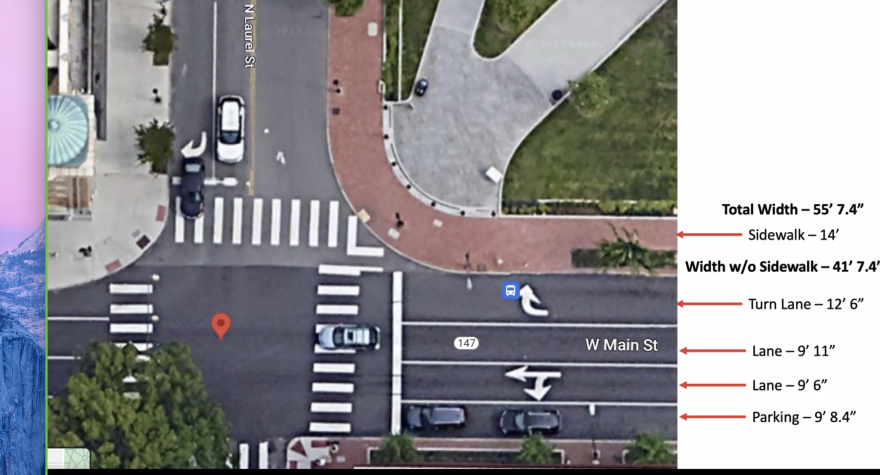The number of car-related pedestrian crashes in the city has been on the mind of Sharon Shaw for some time now.
“I'm just a mom and a pediatrician,” said Sharon Shaw. Over the past months, she has been submitting requests to have Strong Towns hold a Crash Analysis Studio, an ongoing webinar series the group produces.
Strong Towns is a nonprofit media advocacy organization that produces content that “analyzes the failures of the post-war North American development pattern while giving citizens the knowledge and tools to start making our places better today.”
The organization, based in Minnesota, holds community workshops, hosts podcasts and provides data and resources on transportation issues for advocacy groups.
“So Strong Towns had an initiative last year to begin this project of looking at crashes around the country,” said Shaw. “The first crash I submitted was the one on Broad Street that happened where a car flipped and hit a pedestrian on the sidewalk. And it was very dramatic, but it's not normal. Whereas what happened at VCU is actually very normal. Unfortunately.”
On the last Friday morning in January, a student at Virginia Commonwealth University died after being struck by a driver while crossing the street near Monroe Park.
“It is with profound sadness that we share news about the death of VCU student Mahrokh Khan. Just before 9 a.m. this morning, Mahrokh was struck by a vehicle while crossing the street at Laurel and West Main Streets,” wrote Aaron Hart, vice president of student affairs, in an email to students. “She was transported to VCU Medical Center where she was later pronounced dead.”
Also in the VCU email to the school community, college officials offered counseling services and reminded students to share the road, use designated crosswalks and to stay focused at traffic signals.
Two days later, on Jan. 30, another pedestrian was injured on South Laurel Street. In that same general area in 2022 around Monroe Park — near campus buildings and student housing — there were five car-related pedestrian incidents resulting in injuries, according to statistics from the Department of Motor Vehicles.
Mahrokh Khan’s death at that intersection also struck a deeper chord with Shaw, as her son attends the same school.
“He parks in that garage that's right at that intersection and walks to classes right now,” she said.
Strong Towns accepted Shaw’s request for a Crash Analysis Studio and held the webinar last week.
“Last year, over 40,000 people died in automobile crashes in the United States, hundreds of thousands more suffered traumatic injuries,” said program director Rachel Quednau. “And despite the best efforts of public safety officials, these numbers have been increasing, and all of our lives are impacted.”
Quednau, who also moderated the event, said car crashes are caused by multiple factors.
“There's a prevalent misconception that car crashes are caused solely by mistakes that drivers make, looking at your phone, changing the radio, speeding, even drinking alcohol,” she said. “And when a crash occurs, the American response is often to send out law enforcement and insurance agencies merely to assign blame. Who made the mistake that causes [the] crash? Who are we going to put the blame on?”
The goal of holding a crash analysis course, according to Quednau, is to dig deeper into underlying factors that may have caused the accident and come up with recommendations that can happen quickly.
“We need to identify all of the contributing factors and learn what we can from the experience so that we can reduce the number of deaths and traumatic injuries in our communities,” Quednau said.
Problem intersection: Main and Laurel streets
“At this intersection, there's clearly an engineering issue,” said Edward Erfurt, director of community action at Strong Towns. “When I look at the intersection, one of the things that strikes me as odd is that you can see the crosswalk is not actually perpendicular and none of the lines line up to connect — so there's some dysfunction with that.”
Erfurt added the lanes are too wide and the curb radius doesn’t seem to meet American with Disabilities Act requirements. He also said it’s hard for drivers to see some pedestrians on one corner because of a light pole. Erfurt added pedestrians may stand behind it to feel safer as cars go past — but that makes it harder for drivers to see them.

Another factor panelists brought up is speed and the one-way design of Main Street. The posted speed limit at Main and Laurel is 25 mph.
“People shouldn't be using this is like the main thoroughfare to get across town as quickly as possible,” said urban designer Jennifer Griffen. “Because the fact of the matter is you have a ton of users.”
Griffen said she understands that the city wants people to get downtown quickly — and then back out of downtown quickly — but the design is counterintuitive to having people stay in town longer.
“Given the width of the street, the width of the lanes, [the] one-way system is not going to be as conducive to pedestrian safety as a two-way system [is],” she said. Griffen added that with the I-195 nearby, both Main Street and nearby Cary Street should be redesigned as two-way roads.
Panelist Tara Fitzpatrick, the safe routes to school coordinator for Greater Richmond Fit4Kids, said part of the problem is that many streets in the city (including Main Street) were originally designed as commuting highways for residents in the suburbs.
“And it really shouldn't be. Our cities should be safe spaces,” said Fitzpatrick. “So, if there are homes or there are residences, which there is a residence, the huge building right there across the street [referring to the VCU student dorms], then it shouldn't be designated as a highway.”
Recommendation 1: Narrow the road
“We would recommend going out and narrowing this road tomorrow, with cones or delineator sticks,” said Erfurt, who said both VCU and Richmond did this a few years ago when Monroe Park was upgraded and the student housing was getting built.
“We saw the orange barrels that were used before that could be put to remove the extra lanes that aren't necessary and narrow up that pedestrian passage across the travel lanes,” he said. “These are things that could immediately.”
Recommendation 2: Add a crossing guard
Jordyn Taylor is the coordinator for policy and administration at the Partnership for Smarter Growth. Taylor also studied urban and regional planning at VCU. She said one easy, but temporary fix would be to have crossing guards, like they do when there’s a show at the Altria Theater.
“They have crossing guards to ensure pedestrians cross safely,” Taylor said. “I think it would be important to have structures like that during the day, especially because we have peak hours of classes of students walking [to class].”
About a week after Khan’s death, VCU Police held a pedestrian safety campaign, using referee-dressed officers who used whistles and flags to call out pedestrians not crossing properly, according to Axios Richmond.
Recommendation 3: Lower the speed limit
“A couple of years ago, the General Assembly allowed localities to lower speed limits below 25 miles per hour and residential and business districts,” said panelist Brantley Tyndall of Bike Walk RVA. “I think if you're going to talk about pedestrian [safety] in the area, you should lower the speed limit so that you can then design the speed to that appropriate limit.”
Tyndall said the city can attempt to put in pedestrian improvements, but the road’s design encourages drivers to speed.
"We can change the speed limit today if we want. And by ‘we’ I mean, local leaders,” said Tyndall, who added that also putting in speed tables and raised intersections—which cause drivers to automatically slow down would help too.
Tyndall said a few blocks west of the intersection at Main and Laurel, the road gets narrower, there’s a catwalk between two buildings and there’s even more pedestrian activity.
“It feels more constrained. And visually, you get the message that you should drive slower,” he said. But the transition area, as soon as a driver crosses North Belvedere Street on West Main Street, is trickier for drivers. “And I think it doesn't confuse drivers. It loads them into a sense of confidence that they can drive quickly. And that's why the problem is fatal.”
Sharon Shaw agrees that the speed should be reduced.
“If you think about other campuses that are more enclosed, the speed limits are usually 15 miles an hour," Shaw said. “It's crazy slow. But here at VCU, we've got 25 miles an hour right in front of a dorm across from a park. It’s too fast, even if people aren't speeding, and they are speeding. So, it's just impossible.”
Shaw said doing the quick temporary fixes, such as putting up barriers and cones, makes sense.
“See how it works before you spend thousands, millions of dollars on a big fix,” she said, because students “should be able to go to school and not be afraid they’re going to get hit.”



